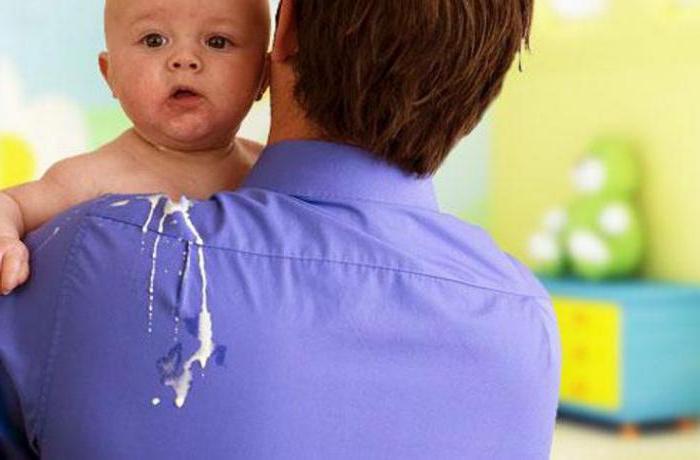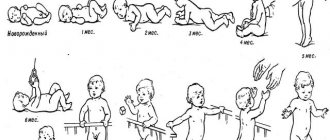Is it possible to treat regurgitation in newborns?
Before we talk about how you can distinguish vomiting from regurgitation in a baby, let's figure out what this process actually is.
It is diagnosed in three quarters of all newborns and is absolutely not considered a pathology. Regurgitation is a physiological variation of the vomiting process. Characterized by a small volume of milk or complementary foods. At one time, the baby’s body can return no more than 30 ml of what was eaten. Regurgitation does not bring any unpleasant sensations to the newborn. He has no spasms or restlessness. Food simply flows freely from the mouth in a small stream. At the same time, the baby remains cheerful and active.
https://www.youtube.com/watch?v=ytpolicyandsafetyen-GB
To know how to distinguish vomiting from regurgitation in a baby (photo below), you just need to observe the occurrence of this phenomenon. As a rule, the baby actively burps immediately after eating or for a maximum of an hour after feeding. This happens especially often in cases where, immediately after feeding, the child begins to bother him, make him laugh, or involve him in active games.
Even if you know exactly how to distinguish vomiting from regurgitation in a baby, it is still better to consult a pediatrician. The fact is that if regurgitation is repeated too often, then something needs to be done about it.
Since during regurgitation the child loses fluid (even if not too much), he must be given additional fluids. It is best to give clean boiled water. Also, soothing teas with chamomile, compote or fruit juice are well suited for this purpose. If dehydration is too severe, you may need to use pharmaceutical medications. "Regidron", "Glucosolan" or "Citroglucosolan" are suitable. They must be diluted according to the instructions, and used only as prescribed by a doctor.
If your baby is artificial, then it is better to switch him to a medicinal formula. For example, “Freesorm” is suitable. It contains a substance such as gum. It retains food in the child's body and does not allow it to return. Nutrilon antireflux also works well, you can try that too.
Most often, regurgitation does not require treatment and goes away on its own over time. But in particularly severe situations, drug intervention may be required. Remember: only a doctor can prescribe medications!
Why does a baby spit up breast milk?
If your baby regurgitates breast milk, this may be due to the following reasons:
- Air is formed in the stomach. The baby may suckle too quickly, resulting in air getting in with the milk, which causes belching. In addition, the mother may not attach the baby to the breast correctly, which is why he also swallows air.
- Binge eating. To avoid regurgitation, you should not overfeed the baby: it often occurs when the mother has a lot of milk and the baby eats more than necessary. If he is bottle-fed, it is necessary to monitor the dosage of the formula.
- Incorrect position of the baby's body after finishing feeding. After eating, the child must be allowed to rest for at least an hour. You should not pick him up, change his clothes, or squeeze his tummy.
If the baby burps no later than an hour after feeding, if he feels well and is gaining weight normally, there is no reason to worry.
Causes of vomiting in infants
To know exactly how to distinguish vomiting from regurgitation in an infant up to one year old, let's talk about the reasons behind the occurrence of such a phenomenon.
The main causes of regurgitation are quite commonplace and most of them can be safely avoided. It could be:
- excessive feeding, which causes overstretching of the stomach walls;
- swallowing excess air;
- inability to attach the baby to the breast;
- forced physical activity immediately after feeding (inhibition);
- shortening the child's frenulum;
- physiologically short upper lip of the baby;
- swaddling too tight;
- gas formation in the baby’s intestines (flatulence);
- a sudden change in position, moving the baby to a vertical position.
Vomiting is a rather complex reflex process. It is directly dependent on overexcitation of the vomiting center or the vagus nerve. Most often, vomiting is accompanied by sharp and frequent spasms. Unlike regurgitation, the volume of substances released will be too large. The fact is that when vomiting, the contents of not so much the stomach, but rather the contents of the upper intestines, begin to protrude from the baby’s mouth, and often from the nose.
Here are some possible reasons for vomiting:
- pneumonia;
- concussion;
- poisoning;
- respiratory tract infection;
- appendicitis;
- otitis media;
- urinary tract infection;
- meningitis;
- sepsis;
- change in intracranial pressure;
- pyloric stenosis;
- abdominal trauma;
- intestinal obstruction;
- diabetic ketoacidosis;
- gastroenteritis;
- strangulated hernia;
- metabolic disease;
- hydrocephalus;
- other ailments.
There can be many reasons, this is not a complete list. It is important to remember one thing here - a healthy child cannot vomit. Therefore, at the slightest suspicion, the child simply needs to be urgently shown to the pediatrician.
There are several signs that you need to call 911 immediately. Delay in this case can end sadly. So, run to the phone if:
- vomiting repeated more than 3-4 times in a row;
- the baby has a high temperature;
- Clots of bile or blood were found in the vomited food;
- vomiting is accompanied by severe abdominal pain, while bowel movements do not occur.

Before the doctors arrive, you need to do everything to alleviate the baby’s condition:
- Never leave your child alone for a minute.
- Place it on its side or hold it in your hands in a vertical or semi-vertical position. This way you can avoid vomit getting into your respiratory tract.
- After the attack stops, rinse the baby’s mouth with cool boiled water.
- Until the cause of the vomiting is determined, do not give your child any food or medications. You can “blur” the picture of the disease and treatment will be very difficult.
- If the doctor is away for a long time, give the child plenty of clean boiled water. In the first hour you need to give one teaspoon every 7-10 minutes.
- Do not panic. The mother’s emotional state is immediately transmitted to the child and he, too, will become nervous and afraid. This will only worsen his condition and may provoke a new vomiting attack.
Why does a baby spit up curdled milk or curd after feeding?
Adequate nutrition is the key to the harmonious growth and development of an infant. This is why young mothers are so afraid of frequent regurgitation in their newborn children. In fact, this process is completely physiological and in most cases does not require medical intervention. Let's figure out why a newborn spits up and what can and should be done about it.
, or gastroesophageal reflux, is the release of small amounts of food from the stomach into the mouth. It can be caused by overeating, swallowing a large amount of air due to improper attachment to the breast, or an excessively large hole in the nipple. Often the cause of rejection of part of the food is colic. Antispasmodic contraction of the stomach walls causes the release of breast milk/formula into the esophagus, and from there through the throat into the oral cavity. If the volume of rejected food does not exceed 3 ml, do not rush to take your baby to see a specialist.

If a child spits up curdled milk, there is nothing wrong with that either. The curdled structure of rejected food is explained by the influence of a special enzyme contained in gastric juice. It is responsible for preparing food for further digestion.
Signs
Well, we’ve sorted out the reasons a little. Now let's talk about the signs. So, how to distinguish vomiting from regurgitation in a baby. Signs of this phenomenon may be:
- the situation repeats irregularly, no more than 2–3 times a day;
- the child remains active and in a good mood all the time;
- the child does not lose weight, but constantly gains weight in accordance with age standards;
- no spasms observed;
- the release of food is one-time in nature (burped up and that’s it);
- milk or other food flows freely from the baby’s mouth;
- the maximum volume does not exceed 20–30 ml (usually much less);
- the child sleeps normally;
- there is no diarrhea, bloating or other signs of illness.
So how to distinguish vomiting from regurgitation in a baby? The characteristic signs of this phenomenon in children under one year of age are so vivid that it is almost impossible to confuse:
- the child does not gain weight;
- meals may be accompanied by difficulty breathing, the child screams and is nervous;
- convulsions appear;
- the fontanel protrudes and seems to swell a little;
- a sour smell appears from the baby’s mouth;
- the mass coming out also has a sour smell, bloody clots or yellowish spots (bile) may be observed in it;
- there is a clear disturbance of stool.
The practical difficulty of how to distinguish vomiting from regurgitation in an infant lies in the individuality of the child’s body. Since children react very differently to such phenomena, you should not think twice and try to justify the eruption of food with a good appetite. We urgently need to show the baby to the doctor and, together with him, choose tactics for further behavior.
Baby spits up a lot when he has a runny nose
A runny nose in a child, especially in infancy, causes many problems for both the baby and the parents. Most often it occurs against the background of colds and in some cases it is accompanied by vomiting. For parents, vomiting from snot in a child is a real disaster; in order to cope with the situation, it is necessary to understand the causes of vomiting and its elimination.
Even a single attack of vomiting that occurs in a child against the background of a runny nose should not go unnoticed by parents, and if vomiting manifestations are episodic or repeated several times during the day, then the alarm should be sounded.
This is due to the fact that such a phenomenon can lead to dehydration of the child’s body. Even such a seemingly banal ailment of a baby, like a runny nose, often entails the occurrence of a gag reflex. However, this phenomenon can cause panic in the child’s parents. This often happens because loving family members are simply afraid of finding themselves helpless in the situation and unable to provide the necessary help.
Nausea and subsequent vomiting occurs in the presence of at least one of the following circumstances:
- Overeating of the baby, as a result of which a gag reflex develops;
- Rhinitis due to colds;
- A sharp, stable increase in body temperature;
- Gastrointestinal diseases (gastritis, appendicitis, biliary dyskinesia);
- Violation of metabolic processes;
- Intestinal infections;
- Intoxication due to poisoning;
- Diseases of the central nervous system;
- Meningitis;
- Overdose or allergic reaction to certain medications or their individual components;
Vomiting can be functional in nature, manifesting itself in the form of regurgitation after a heavy meal. Also, snot and its further flow down the back wall of the larynx can provoke a gag reflex.
An anatomical feature of infants is narrow nasal passages.
The development of a runny nose during this period is accompanied by swelling of the mucous membrane of the nasal cavity, as a result of which nasal breathing becomes significantly more difficult, the baby may often be capricious, refuse sleep and food, and cry. For babies, every meal plays an important role, so systematic regurgitation or refusal to eat due to a runny nose can lead to significant weight loss in the baby, which can affect its physical development.
Attacks of vomiting and snot in children can occur almost simultaneously. This is due to the fact that infants and children aged 2-3 years do not know how to blow their nose. As a result, it becomes difficult to clear mucus that has accumulated in the nose. This usually happens if parents do not suck out the mucus from the child’s nasal cavity with an aspirator in time. Eventually, mucus slowly drains from the nasal cavity down the back of the throat.
This type of runny nose in infants is called posterior runny nose; its characteristic symptom is often special “grunting” sounds that become audible when inhaling. Mucus infected with viruses or bacteria irritates the nasopharynx receptors, as a result of which the child first has a cough and then begins to vomit. The baby can swallow some of the snot, and then it penetrates the gastrointestinal tract. This process can also trigger the gag reflex.
Very often, a cold with the subsequent development of a runny nose can cause physiological regurgitation, which turns into vomiting. This is due to the fact that a child with a runny nose while eating has to swallow a certain amount of air through his mouth, which naturally enters the stomach.
If the necessary measures are not taken, the air that has entered the stomach along with the food consumed will come out, and the baby will burp. To avoid this, after completing the feeding process, it is recommended to bring the baby to an upright position. This maneuver will ensure the safe release of air from the stomach without further regurgitation and then vomiting.
The main thing to do if a child is vomiting is not to panic. It is known that an unstable emotional background very quickly spreads to the baby, so such problems should be approached competently and the necessary actions taken as the situation worsens.
- If your baby vomits due to a runny nose, you should position him correctly to avoid aspiration of the vomit into the respiratory tract. It is necessary to place the child on his side and slightly raise his head. This position will help the baby not to choke if a repeated attack of vomiting occurs;
- Provide plenty of fluids to restore electrolyte balance. If a child vomits, there will be a lack of fluid in his body, so you should give the baby at least a few sips of water, even if he refuses.
Due to the fact that vomiting is a complication of the underlying disease, and not its immediate cause, the elimination of such a manifestation should begin with the treatment of a runny nose.
- Usually, when a runny nose occurs, young children have their nasal passages cleaned before each feeding. This can be easily done using cotton swabs soaked in a light solution of soda (1⁄2 teaspoon per glass of water). After clearing the nasal cavity of mucus, you can drop 1-2 drops of breast milk into each nostril. It contains a large number of protective microelements that the human body produces throughout its life. When the mother does not have milk, you can replace it with a couple of drops of warm vegetable oil.
- During a runny nose, the nasal mucosa produces a large amount of virus-neutralizing elements, so the snot should never dry out. To do this, you should provide access to fresh, cool air in the room, as well as maintain the required level of humidity. This can be achieved by wet cleaning the house 3-4 times a day and frequent ventilation. Such manipulations contribute to the death of bacterial infection in a confined space, because pathogens multiply exclusively in warm and still air;
- Drinking a fortified drink or a large volume of water will help replenish the volume of fluid in the child’s body and will not allow the snot to dry out;
- Moisturizing the nasal passages with drops will help your child cope with a runny nose. The most accessible and common remedy is saline solution, which can be bought at any pharmacy and even prepared yourself. To do this, you will need to add 1 teaspoon of salt to 1 liter of boiled and cooled water. You can safely instill 4-5 drops of the solution once an hour, alternately into each nostril;
- To prevent mucus from drying out, it is allowed to use oil solutions of vitamins A and E. They can be instilled 1-2 drops every two hours in combination with saline;
- An important criterion for treating a child’s runny nose is timely cleaning of the nasal cavity using an aspirator. It is necessary to suck out snot not according to time or at certain hours, but as it accumulates. While a three-year-old child can warn his parents about what is bothering him, an infant is unable to do this. He needs constant monitoring and at the slightest hint of difficulty breathing, you should immediately resort to using an aspirator, otherwise vomiting cannot be avoided.
- It is important to understand that under any circumstances it is forbidden to instill antibiotic solutions and vasoconstrictor drops into a child’s nose. They tend to bring short-term relief of symptoms, but subsequently severe swelling of the nasal mucosa appears. It is important not to aggravate the condition by self-medication, especially in the absence of elevated body temperature. Before the attending physician arrives, it is enough to calm the baby, if possible, put him to bed and provide him with plenty of fluids. During this period, it is not recommended to feed the child food containing coarse fibers, as this can provoke repeated irritation of the nasopharynx and further vomiting.
Along with a runny nose, vomiting in a child is a protective reaction of the body to a pathogenic irritant or infection. In this way, the body copes with the cause of the illness, be it a cold, an intestinal infection or an allergic reaction. If attacks of vomiting occur or become more frequent, you should contact your pediatrician to determine the causes of their occurrence and prevent possible complications.
source
A runny nose is a disease that we have become accustomed to since childhood, and we consider it quite harmless. But is it so harmless for babies? A newborn baby is not yet strong enough and does not have a strong enough immune system. But rhinitis poses a real threat even to an adult. We will try to figure out the cause of a runny nose in infants and find out what to do if it appears.
Snot in babies most often appears in the autumn-winter period. You should not ignore them, because this may be the first signal of an onset of a cold. Even minor discharge from a small nose causes significant discomfort to the baby. It becomes more difficult for him to breathe, he becomes restless and irritable. And with a stuffy nose, it is more difficult for a baby to suckle at the breast. Parents, of course, want to help their child as quickly as possible. But how? What do you need to do to quickly cure rhinitis without harming your tiny body? If you do not take this situation seriously enough or treat rhinitis incorrectly, you can expect serious complications, and they can lead to chronic respiratory diseases.
Most often, rhinitis becomes the first bell, which signals that an infection has entered the body and a cold is beginning. After all, the nose becomes the organ through which pathogenic bacteria and viruses enter the body. It can also be a clear sign of gastrointestinal dysfunction. In older children, snot can be a sign of allergies if there has been contact with any allergen, for example, food. Another cause of a runny nose can be pathological changes in blood vessels. But this phenomenon occurs quite rarely in infants. If you have such symptoms, you should immediately contact your pediatrician, or maybe even an otolaryngologist.
There are several types of runny nose that are found only in infants or newborns.
At the age of 2-3 months, mucus discharge begins to appear from the baby’s nose. There may even be some impurities in the form of a curdled mass. The reason for its appearance is quite banal. After all, newborns often burp. The contents of the stomach enter the anus of the nose during regurgitation. Such a runny nose poses virtually no danger, but it is better to place the baby on its side so that it does not choke.
There is also a runny nose associated with the teething process. This is what they call “tooth snot”. The fact is that as the baby’s first teeth appear, the amount of saliva and nasal discharge often increases. Then you just need to measure the temperature. If it is within normal limits, then there is no reason to panic. Also take a closer look at how the baby behaves, whether his general condition has worsened. If the behavior has not changed, then you don’t have to see a doctor for now.
Another type of runny nose in infants is “false runny nose.” It may appear at about 2 months. At the same time, you will notice that he began to actively salivate and discharge from his nose. And in this case there is no reason to be afraid. It’s just that by two months the formation of the salivary glands ends, and they begin to work at full capacity. But by this time the baby had not yet learned to swallow saliva well enough. Therefore, it can flow out of the mouth and also into the nose. The baby will begin to blow bubbles, cough and periodically choke from excess saliva. Again, you need to see if the child remains cheerful and cheerful. If you understand that nothing bothers him except this temporary discomfort, then you don’t need to do anything. In a few days, he will begin to cope with the new volume of saliva and the “false runny nose” will pass.
Snot in a newborn is always a reason to take a closer look at his condition. After all, they can signal that a cold is beginning. But this is not always a sign of illness. In infants, the structure of the nasal cavity has anatomical and physiological features. Their nasal canals are much shorter and narrower than those of adults. Therefore, if their mucous epithelium swells, then breathing becomes much more difficult. When feeding, it will be much more difficult for the baby to hold the breast or pacifier. A stuffy nose can limit or even temporarily stop the free flow of air.
In a newborn and infant, the nasal passages are still located at a different angle than in an adult. Therefore, swelling and inflammation quickly spread to the mucous membrane of the respiratory tract. This means that the larynx, trachea, and bronchi can become inflamed very quickly. Infants with rhinitis can quickly develop a complication such as otitis media. After all, the Eustachian tube is directly connected to the nasal canals. Therefore, the inflammation that occurs in the nose quickly spreads to the mucous membrane of the ears.
From everything said above, the conclusion is this. A runny nose in a baby can lead to inflammation of the airways, which are located below the nasal cavity, and can also soon lead to the development of otitis media. Therefore, if the baby really has rhinitis, you should immediately consult a doctor and begin adequate treatment.
If you have ruled out variants of a runny nose such as regurgitation, “tooth snot” or “false runny nose”, then most likely your child will develop rhinitis. It is very important not to miss the moment and consult a doctor in a timely manner.
Cases in which consultation with a pediatrician is necessary:
- the baby has refused to breastfeed and is clearly restless;
- the discharge clearly prevents the baby from breathing freely, and the runny nose has persisted for a long time;
- the baby has wheezing in the area below the throat;
- a cough appeared, which is not associated with an excess of saliva.









